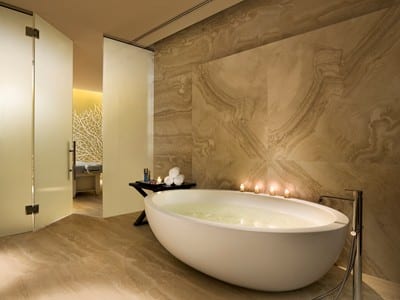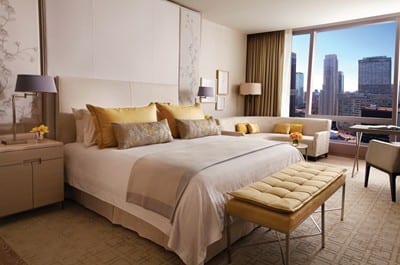Dynamic Duo
George Yabu and Glenn Pushelberg discuss designing for living, the need for real service, and what hotels can learn from Hertz.
By Stacy Shoemaker Rauen
 George Yabu and Glenn Pushelberg, the pair behind Toronto- and New York-based Yabu Pushelberg, are redefining what luxury means today, one hotel at a time. And they are just getting started, working for-and in some cases, helping to brand-the likes of Four Seasons, Edition, Starwood, and Waldorf Astoria, in as far-reaching places as Mumbai, Guangzhou, Rio de Janeiro, and London. Here, they discuss designing for living, the need for real service, and what hotels can learn from Hertz.
George Yabu and Glenn Pushelberg, the pair behind Toronto- and New York-based Yabu Pushelberg, are redefining what luxury means today, one hotel at a time. And they are just getting started, working for-and in some cases, helping to brand-the likes of Four Seasons, Edition, Starwood, and Waldorf Astoria, in as far-reaching places as Mumbai, Guangzhou, Rio de Janeiro, and London. Here, they discuss designing for living, the need for real service, and what hotels can learn from Hertz.
HD: You just finished the much-anticipated St. Regis Bal Harbour. Why do you think so many people were excited about the opening?
GP: The hotel has brought to Miami something that existed many, many years ago in the sixties when there were big, grand hotels built like the Fontainebleau and Eden Rock. That’s where all the great singers of that time-Frank Sinatra and Dean Martin-came to entertain. People got dressed up, and the hotels were very fancy, special places that became social centers. There’s been an obvious metamorphosis in Miami about making hotels like bars, but I think that phase is over. The funny thing about Bal Harbour is it never had a shopping mall as its social center, so the hotel is a wonderful addition to that town. And to Miami, it’s a very glamorous, uptown destination where not only hotel guests, but also locals will be driven to come. It’s a little bit Art Deco. What Starwood allowed us to do, which you will find very difficult anywhere now, is [work with a] relatively unlimited budget to make it right.
GY: Also, it’s a design destination that’s an alternative to South Beach proper. Glenn was alluding to the fact that there was a lot of fast, curious, high design throughout South Beach, and [locals] are getting kind of wary or tired of it, maybe somewhat jaded. So this will allow them to get away from it and still be surrounded by a high level of design.

HD: Most of your clients are high-end brands. What are they looking for in terms of luxurious design?
GP: People who come to us are looking for an alternative to the old fashioned formula of what makes a 5-Star hotel.
GY: The old meaning of luxury.
GP: Yes, the old meaning of luxury and the old way that people used hotels. We get clients who are reaching to what the future is. What does the next generation want? How do they live in hotels? Not only on an aesthetic basis, but also on how they use them. You tow this fine line of appealing to existing customers and the new generation. If you think about how we live today, we don’t necessarily eat in formal dining rooms in our homes. We’ll snack a little bit in front of the television, or we’ll work on our tablet in the bedroom-all of this is mashed together. Customers also want more choices in the way they dine. They don’t necessarily want to have to order the big seventy-dollar breakfast. They want to have the choice: a full sit-down service or a continental breakfast in a living room setting. You have to start thinking about how people have changed the way they live. Hotels should be leading that rather than following.
In the rooms, obviously, it’s been noted for years that bathrooms and beds are more important, but less important are things like a working desk. We had this debate many times with 5-Star hotel operators. It’s usually the older team members who want a big desk and the younger members of the team say, ‘Why don’t we just make a higher sofa and a taller table so that you can work on your tablet in a more comfortable setting.’It’s interesting how this is evolving.
HD: It definitely is. There has also been a lot of debate about minibars.
GP: There’s this old fashioned [thought] about charging for wifi or overcharging for minibars. You’ll see some of the new operators saying, ‘I’m just going to include the price of everything in the pantry, and the pantry is yours.’It’s easy. If you’re charging eight hundred dollars a night for a room, why not give it to them? I think that either the minibar is going to become a pantry or it’s going to become nothing, but it doesn’t make any sense as it exists. It’s not customer driven. The big hotel companies get into their systems and habits and they’re hard to break, but they forget about their customers.
[In a brainstorming session to rethink Hilton’s lobby] this guy who’s one of their road warriors says, ‘The problem is I’ve got to tip everybody that opens the door. I wait in line at the front desk for a two hundred-dollar room, and then I go to my room. When I rent a Hertz Rent-a-Car, I don’t have to talk to anybody. I just get in the car, I show them my driver’s license, and I’m gone because everything is recorded.’And this guy is getting in a sixty-five-thousand-dollar car versus a two hundred-dollar a night room. What it says to us is that it goes back to the old, simple things-you have to think like a customer.
HD: You both are constantly traveling. What are some of your hotel pet peeves?
GY: Overcomplicated lighting controls and inconvenient outlets that are stuck way behind night tables-the basic stuff that you get really annoyed at.
GP: The one thing that annoys me is when everything is systemized-my greeting, glancing at the computer screen so they can see my name, and then calling me by my name like they’re my friends. All of that is constructed to annoy me because when I ask them to leap to give me real service it doesn’t exist. For example, a year or so ago I was staying at the Park Hyatt in Shanghai, and I called and asked, ‘Do you have the Wall Street Journal?’And they said, ‘Sorry sir, we’re out.’Then fifteen minutes later this guy knocks on my door, and he said, ‘Here’s the Wall Street Journal.’I said, ‘Where did you get it?’ He said, ‘I went across the street to another hotel and bought it for you.’Now that’s real service-not relying on this computerized memorizing and giving people the responsibility or the ability to reach beyond what they’re trained to do. I think that’s really the difference.
HD: When you are designing all these luxurious hotels for various brands in different locations, how do you start the design process?
GP: For the last two years, we have been creating an imaginary couple who are building a house, and the description of the couple is the program of the hotel. You can create this story that becomes a context of making something that’s very personal and specific for the place. From a design point of view, it’s also very important that you don’t create these cookie-cutter hotels or fall into the trap of generically contextualizing things. [This way] they become more personal.
HD: What hotel are you working on that you are really excited about?
GY: The Four Seasons in Toronto. It’s a block away from the original Four Seasons downtown, and it’s going to be a place where every Four Seasons Hotel owner will probably eventually stay when they come and visit. The DNA of the Four Seasons is there, but it’s a modern departure from where they had been in Toronto, so it’s going to be a breath of fresh air. Even though it’s a brand new hotel, the whole thing unfolds like a beautiful and very elegant residence, which I think is missing in a lot of urban hotels.
GP: What’s interesting about Four Seasons is there’s now a vice president of innovation, and they’re pushing to change and modernize the way they think, what kind of services they give their guests, what the physical environment should be-turning the brand upside down a bit. That’s really refreshing, and it’s become an exciting time for Four Seasons again because of that.

HD: And the Edition in London, opening in December?
GP: It’s the old Berners Hotel across from the Sanderson. It’s a very ornate, Rococo-ish interior, and we’re juxtaposing that against something very severe and modern. Not modern, but very…
GY: Spare. It’s a restoration.
GP: There aren’t any tricks in the hotel. There is a lot of clarity to the design. [Ian Schrager] is more concerned with comfort and beauty now than overdesign and tricks like he was before. I think he will have something that’s really quite incredible. And he’s very involved. Both Editions in London and Miami, which will open in 2013 [and we are also designing], will set a new standard for lifestyle hotels in terms of their aesthetic direction.
HD: How so?
GP: It’s a lifestyle hotel that fits below a conventional 5-Star hotel and above the trendier Ws of the world. There’s a niche for people who are grown up but don’t want a stuffy place and prefer a more modern approach to food and beverage and how they live. It’s for people who want to live in a modern way, and they’ve come to see ‘designed hotels’as being overdesigned and underserved. All of these high-designed hotels happened pre-recession without good service, which is counterintuitive to the way things are going today.



